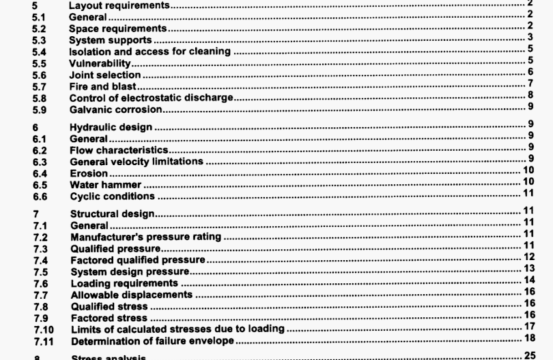ISO 14692-3 pdf download – Petroleum and natural gas industries —Glass-reinforced plastics (GRP) piping-Part 3: System design.
8 Stress anafysis
8.1 AnalysIs methods
Either manual or computer methods shall be used for the structural analysis of p4ping systems However, the degree of analysis depends on the folIoww9 (actors:
a) ppework flexd,dity;
b) layout comptexily.
C) pipe supports;
d) pipework diameter;
•) magnitude of temperature changes;
f) system cfltlcality and failure risk assessment
As the pipe diameter increases, the pipework tends to become less flexible ana me stress Wllenslflcabon
factors at bends and tees increase
8.2 AnalysIs r.qulr.m.nts
8.2.1 General
The designer shall evaluate the total pipwig system. Indusive of system cflticakty and flak of failur, due to operating/material factors. in order to assess the need for flexibullly/stress analysis. At large diameters, the design of the pipe may be determined more by the support conditions than the Internal pressure conditions. Mchor (support) loading shal be checked lot acceptabilIty. The wiformatlon listed In 8.22 and 8.2.3. as a minimum. shail be obtained before performing flexibllitylstress analysis.
NOTE ml dimensions of GRP piping are usuaty referenced r terme of the wwier dame4er and wall th,dLrIess becai of the nature of 5* P’n.nUfaCIUeInQ process
8.2.2 InstallatIon and design parameters
These parameters include:
a) design and working pressure of the pipe;
b) desagn and worlung temperature of the pipe;
c) mass per unit length of pipe component contents;
d) valve types and masses of al valves and other in-line items
e) routing dWnensions;
f) environmental loadings;
g) magnitude of possible support displacement during lilting operations;
h) magnitude of support displacement caused by huN flexxe of mobile facilities;
I) acceleration forces and displacements caused by mOtiOn of mobile facilities.
The fire endurance properties of GRP piping may be different for pipes containing fluids other than water, for example produced water, glycol, diesel fuel lines and closed drains. The designer shall be satisfied that the GRP piping can provide the required fire resistance under these conditions This may require a risk analysis andlor additional testing to be cameo out
9.3 Fire reaction
Fire reaction is concerned with the following properties:
a) ease of ignition;
b) surface spread of flame characterisbcs;
c) rate of heat release;
d) smoke emissions;
e) toxic gas emissions.
Guidance on the quantification of appropriate fire reaction properties is given in Annex F. The designer shall assçn the required tire performance of the piping system according to the classification code given in Table 8 of ISO 14692-2:2002. The fwe reaction classification code is designated by a two-field number, where spread of fire and heat release D, and smoke and toxicity E are assigned prescribed levels in decreasing order of seventy. It is not necessary (ci’ the entire piping system to have the same fire classification. The designer may assign more than one fire classification code requirement according to location etc.
9.4 FIre-prot.ctive coatings
The designer shall consider the following when determining the performance of the fire-protective coating.
a) Fire risk (fire zone) and fire type for the area m which the piping is installed;
b) type, grade and diameter(s) of pipe;
c) jointing system(s) used;
d) whether the piping Is dry” or contains stagnant or flowing water;
e) type and thickness of passive fue-protective coating;
1) effect of long-term weathering, exposure to salt water, temperature and exposure to uv radiatIon;
g) effect of flexing, vibration, mechanical abuse, impact and thermal expansion;
h) liquid-absorption properties of the coating and piping. The fre-protective properties of the coating should not be diminished when exposed to salt water, oil or bilge slops;
i) ease of attachment of the coating under site conditions and the effect of interfacial liquid entrapment. The adhesion qualities of the coating should be such that the coating does not flake, chip, or powder when subjected to an adhesion test;
J) ease of repair.
The fire-protective coating should preferably be applied by the manufacturer in the factory. The application of fire-protective materials to achieve the flame spread, smoke or toxicity requirements shaft be permanent to the pipe construction. On-site application of such materiel shall be limited that required for installation purposes, e.g. field joints. If a fire-protective coating Is used for the sole purpose of meeting the fire endurance requirements, the pipes may be coated on-site in accordance with the approved procedure for each combination, using the approved materials of both pipes and insulation, subject to on-site inspection and verification.
ISO 14692-3 pdf download – Petroleum and natural gas industries —Glass-reinforced plastics (GRP) piping-Part 3: System design
